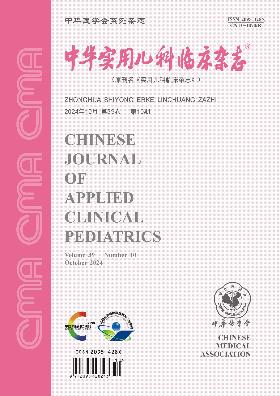血小板分布宽度对神经母细胞瘤预后的预测价值
Q4 Medicine
引用次数: 0
摘要
目的探讨血小板分布宽度(PDW)是否能有效预测神经母细胞瘤(NB)的预后。方法回顾性分析郑州大学第一附属医院2014年1月至2018年1月收治的67例NB患者的临床资料。根据PDW水平将其分为低PDW组和高PDW组,并比较两组临床指标的差异。采用Kaplan-Meier方法和Cox回归模型评估PDW的预后影响。结果67例患者中,男性41例,女性26例,男女比例为1.58∶1.00,平均年龄44个月(2~156个月)。Ⅰ期5例,Ⅱ期1例,Ⅲ期15例,Ⅳ期46例。首次诊断时,年龄≤18个月的14例,年龄>18个月的53例,神经元特异性烯醇化酶(NSE)水平≥100μg/L的47例,NSE水平0.05的20例,高PDW组的MYCN基因扩增率和红细胞分布宽度显著高于低PDW组,生存分析显示,低PDW组的2年总生存率显著高于高PDW组(69.8%vs.25.3%,χ2=15.761,P<0.05),肿瘤风险分层(HR=5.926,95%CI:1.416-24.794)、PDW(HR=4.036,95%CI:1.957-8.322)和红细胞分布宽度(HR=1.120,95%CI:1.005-1.249)是影响总生存率的不利因素,多因素分析表明PDW是NB的独立危险因素(HR=2.524,95%CI:1.017-6.264,P=0.046)。PDW增加与NB患者的不良预后相关,PDW是NB预后不良的独立危险因素。关键词:神经母细胞瘤;血小板分布宽度;预后;总体生存率本文章由计算机程序翻译,如有差异,请以英文原文为准。
Predictive value of platelet distribution width on prognosis of neuroblastoma
Objective
To discuss whether platelet distribution width (PDW) can effectively predict the prognosis of neuroblastoma (NB).
Methods
The clinical data of 67 NB patients in the First Affiliated Hospital of Zhengzhou University between January 2014 and January 2018 were retrospectively analyzed.They were divided into low PDW group and high PDW group according to the PDW level, and the differences in clinical indicators between the 2 groups were compared.The prognostic effects of PDW were assessed by using the Kaplan-Meier method and Cox regression model.
Results
Among the 67 patients, 41 cases were male, 26 cases were female, with the ratio of male to female being 1.58∶1.00, and the average age was 44 months (2-156 months). Five cases were in stage Ⅰ, 1 case in stage Ⅱ, 15 cases in stage Ⅲ and 46 cases in stage Ⅳ.At the first time of diagnosis, there were 14 cases with age ≤ 18 months, 53 cases with age > 18 months, 47 cases with neuron specific enolase (NSE) level ≥ 100 μg/L, 20 cases with NSE level 0.05). The proportion of high-risk patients, the level of NSE, bone marrow metastasis rate, MYCN gene amplification rate and the red blood cell distribution width in the high PDW group were significantly higher than those in the low PDW group, but the high PDW group had a lower level of thrombocytocrit than the low PDW group, and the differences were statistically significant(all P<0.05). Survival analysis revealed that the 2-year overall survival of the low PDW group was significantly higher than that of the high PDW group (69.8% vs.25.3%, χ2=15.761, P<0.05). Univariate analysis showed that NSE (HR=6.606, 95%CI: 2.018-21.620), MYCN gene (HR=1.977, 95%CI: 0.794-4.919), tumor risk stratification (HR=5.926, 95%CI: 1.416-24.794), PDW (HR=4.036, 95%CI: 1.957-8.322), and red blood cell distribution width (HR=1.120, 95%CI: 1.005-1.249) were the adverse factors affecting the overall survival, and thrombocytocrit was a protective factor for the prognosis of NB.Multivariate analysis indicated that PDW was an independent risk factor of NB (HR=2.524, 95%CI: 1.017-6.264, P=0.046).
Conclusions
There is a good consistency between the increase of PDW and the known prognostic risk factors, elevated tumor markers and bone marrow metastasis.Increased PDW is associated with poor prognosis in NB patients, and PDW is an independent risk factor for the poor prognosis of NB.
Key words:
Neuroblastoma; Platelet distribution width; Prognosis; Overall survival
求助全文
通过发布文献求助,成功后即可免费获取论文全文。
去求助
来源期刊

中华实用儿科临床杂志
Medicine-Pediatrics, Perinatology and Child Health
CiteScore
0.60
自引率
0.00%
发文量
14243
期刊介绍:
Chinese Journal of Applied Clinical Pediatrics ( semi-monthly ) is a core journal of paediatrics under the supervision of China Association for Science and Technology, sponsored by Chinese Medical Association and undertaken by Xinxiang Medical College. Founded in 1986, it is openly circulated both at home and abroad. The journal has several columns, such as Expert Forum, Experimental Research and Paediatric Surgery, which are mainly for paediatric medical workers and medical researchers in hospitals. Its purpose is to reflect the new theories and technologies in paediatric medicine and scientific research at home and abroad, and to promote academic exchanges.
Chinese Journal of Applied Clinical Pediatrics is a source journal of China Science Citation Database (CSCD), a core journal of Peking University, a source journal of Chinese science and technology paper statistics (China Science and Technology Core Journals), a core academic journal of RCCSE, a high-quality scientific and technical journal of China, a high-quality scientific and technical journal of China Association for Science and Technology, and a high-quality scientific and technical journal of China Biomedical Science and Technology Association. We have been published in China Biomedical Literature Database (SinoMed), China Knowledge Network, Wanfang Data Knowledge Service Platform, China Academic Journal Abstracts, Scopus Database, Chemical Abstracts (USA), Japan Science and Technology Agency (JSTA) Database, Copernicus Abstracts (Poland), Abstracts of the Centre for Agricultural and Biological Sciences (CABS) of the United Kingdom, Cambridge Scientific Abstracts ProQuest Database, WHO Medical Journal of the Western Pacific Region (WMPR), and WHO Medical Journal of the Western Pacific Region (WMPR) of the United States. We have been included in dozens of authoritative databases at home and abroad, such as WHO Western Pacific Region Index of Medicine (WPRIM), Ullrich's Guide to Periodicals, and so on.
 求助内容:
求助内容: 应助结果提醒方式:
应助结果提醒方式:


